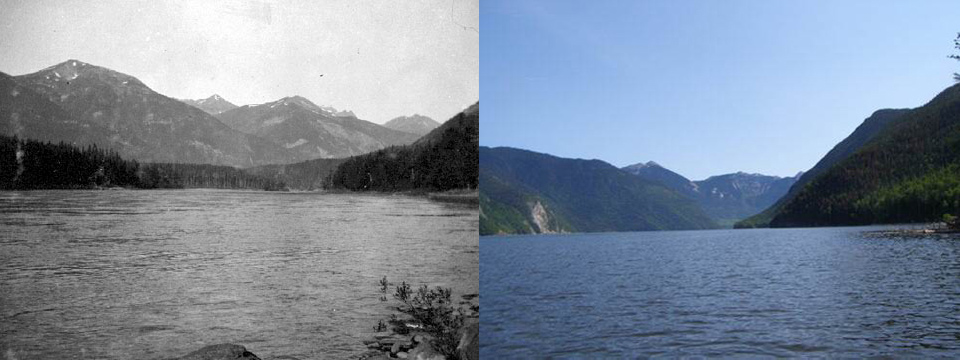Peace River flowing through the Rocky Mountains in 1901 (BC Archives), and Lake Williston hydro-reservoir in c. 2000 (S.M. Rooke, Panoramio). A better located rephotograph is required, but the exact photopoint is now under water.
Traversing the Peace River Break through Rocky Mountains
For nearly two week in latter May and early June 1793, Alexander Mackenzie ascended the Peace River where it breaks through the Rocky Mountains from the west. Today, most this area is submerged under hydro-electric reservoirs, including massive Lake Williston, held behind the Bennett Dam. Once west of the Rocky Mountains, Mackenzie followed the directions of an old native warrior, and turned southwards up the Parsnip River. He was now passed through the homelands of the Tse’khene (Sekani) into those of the Dakelh (Carrier) peoples. Remarkably, even early as 1793, less than a decade of the Europeans reaching the coast, these interior nations were already making use of iron for the points of arrows and spears. A Dakelh described a trade route directly to the west, likely up the Nechako River.
Their iron-work they obtained from the people who inhabit the bank of that river, and an adjacent lake, in exchange for beaver skins, and dressed moose skins. They represented the latter as travelling, during a moon, to get to the country of other tribes, who live in houses, with whom they traffic for the same commodities; and that these also extend their journies in the same manner to the sea coast, or, to use their expression, the Stinking Lake, where they trade with people like us, that come there in vessels as big as islands. 1.
Mackenzie was looking for a river that descended to the Pacific, thus after interviewing several local hunters, he obtained a description of a set of portages that would take him to what is now the Fraser River.
<Previous page Chapter Overview Next page>
Map and Footnotes
- The Journals of Alexander Mackenzie p. 258 ↩
